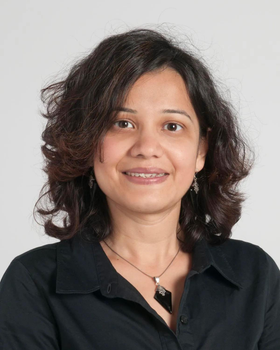Amblyopia Overview
Learn About Amblyopia
Amblyopia is the loss of the ability to see clearly through one eye. It is also called "lazy eye." It is the most common cause of vision problems in children.
Lazy eye; Vision loss - amblyopia
Amblyopia occurs when the nerve pathway from one eye to the brain does not develop during childhood. This problem develops because the abnormal eye sends the wrong image to the brain. This is the case in strabismus (crossed eyes). In other eye problems, a blurred image is sent to the brain. This confuses the brain, and the brain may learn to ignore the image from the weaker eye.
Strabismus is the most common cause of amblyopia. Having a family member with strabismus, increases your chance of having strabismus.
The term "lazy eye" refers to amblyopia, which often occurs along with strabismus. However, amblyopia can occur due to something other than strabismus. Also, people can have strabismus without amblyopia.
Other causes include:
- Childhood cataracts
- Farsightedness, nearsightedness, or astigmatism, especially if it is greater in one eye
In strabismus, the only problem with the eye itself is that it is pointed in the wrong direction. If poor vision is caused by a problem with the eyeball, such as cataracts, amblyopia will still need to be treated, even if the cataracts are removed. Amblyopia may not develop if both eyes have equally poor vision.
Symptoms of the condition include:
- Eyes that turn in or out
- Eyes that do not appear to work together
- Inability to judge depth correctly
- Poor vision in one eye
The first step will be to correct any eye condition that is causing poor vision in the amblyopic eye (such as cataracts).
Children with a refractive error (nearsightedness, farsightedness, or astigmatism) will need glasses.
Next, a patch is placed on the normal eye. This forces the brain to recognize the image from the eye with amblyopia. Sometimes, drops are used to blur the vision of the normal eye instead of putting a patch on it.
Newer treatment techniques use digital computer technology, to show a slightly different image to each eye. Over time, the vision between the eyes becomes equalized.
Children whose vision will not fully recover, and those with only one good eye due to any disorder should wear glasses. These glasses should be shatter- and scratch-resistant.
Cleveland Clinic Main Campus
Fatema Ghasia is an Ophthalmologist in Cleveland, Ohio. Dr. Ghasia is rated as an Elite provider by MediFind in the treatment of Amblyopia. Her top areas of expertise are Amblyopia, Strabismus, Brown Syndrome, Esotropia, and Deep Brain Stimulation.
Robert Hess practices in Montreal, Canada. Mr. Hess is rated as an Elite expert by MediFind in the treatment of Amblyopia. His top areas of expertise are Amblyopia, Strabismus, Brown Syndrome, and Concussion.
Banner-University Medical Group
Jonathan Holmes is an Ophthalmologist in Tucson, Arizona. Dr. Holmes is rated as an Elite provider by MediFind in the treatment of Amblyopia. His top areas of expertise are Strabismus, Brown Syndrome, Amblyopia, Cataract Removal, and Trabeculectomy. Dr. Holmes is currently accepting new patients.
Children who get treated before age 5 almost always recover vision that is close to normal. However, they may continue to have problems with depth perception.
Permanent vision problems may result if treatment is delayed. Children treated after age 10 can expect vision to recover only partially.
Complications may include:
- Eye muscle problems that may require several surgeries
- Permanent vision loss in the affected eye
Contact your health care provider or eye doctor if you suspect a vision problem in a young child.
Identifying and treating the problem early prevents children from having permanent visual loss. All children should have a complete eye exam at least once between ages 3 and 5.
Special methods are used to measure vision in a child who is too young to speak. Most eye care professionals can perform these techniques.
Summary: Based on the Tongren Myopia and Amblyopia Therapeutic Apparatus (a 650nm low-level red-light device) developed by the research team in the previous phase, the device was modified by replacing the light source with LED light. Subsequently, a population study was conducted to evaluate its efficacy and safety in myopia prevention and control.
Summary: In children 4 to 7 years of age, to determine if treatment with 1 hour per day 6 days per week of watching dichoptic movies/shows wearing the Luminopia headset is non-inferior to treatment with 2 hours of patching per day 7 days per week with respect to change in amblyopic eye distance VA from randomization to 26 weeks.
Published Date: July 09, 2024
Published By: Audrey Tai, DO, MS, Athena Eye Care, Mission Viejo, CA. Also reviewed by David C. Dugdale, MD, Medical Director, Brenda Conaway, Editorial Director, and the A.D.A.M. Editorial team.
Bircg EE, Duffy KR. Amblyopia. In: Yanoff M, Duker JS, eds. Ophthalmology. 6th ed. Philadelphia, PA: Elsevier; 2023:chap 11.11.
Olitsky SE, Marsh JD. Disorders of vision. In: Kliegman RM, St. Geme JW, Blum NJ, et al, eds. Nelson Textbook of Pediatrics. 22nd ed. Philadelphia, PA: Elsevier; 2025:chap 661.
Repka MX. Amblyopia: the basics, the questions, and the practical management. In: Lyons CJ, Lambert SR eds. Taylor and Hoyt's Pediatric Ophthalmology and Strabismus. 6th ed. Philadelphia, PA: Elsevier; 2023:chap 74.
Xiao S, Angjeli E, Wu HC, et al. Randomized controlled trial of a dichoptic digital therapeutic for amblyopia. Ophthalmology. 2022;129(1):77-85. PMID: 34534556 pubmed.ncbi.nlm.nih.gov/34534556/.
